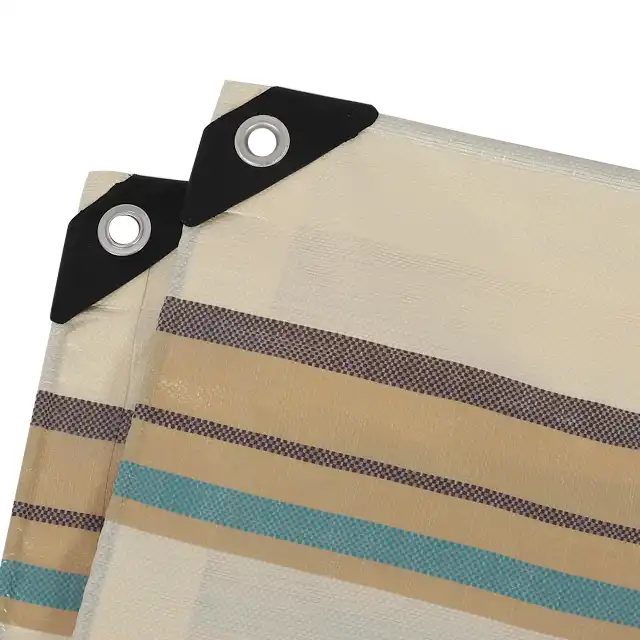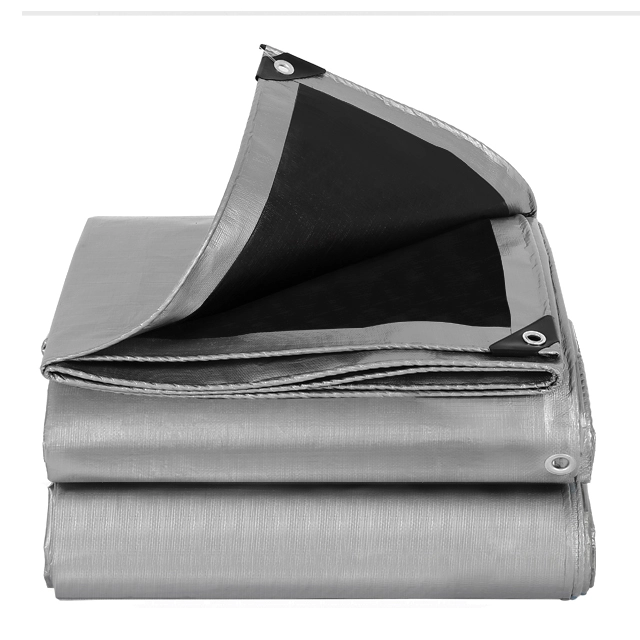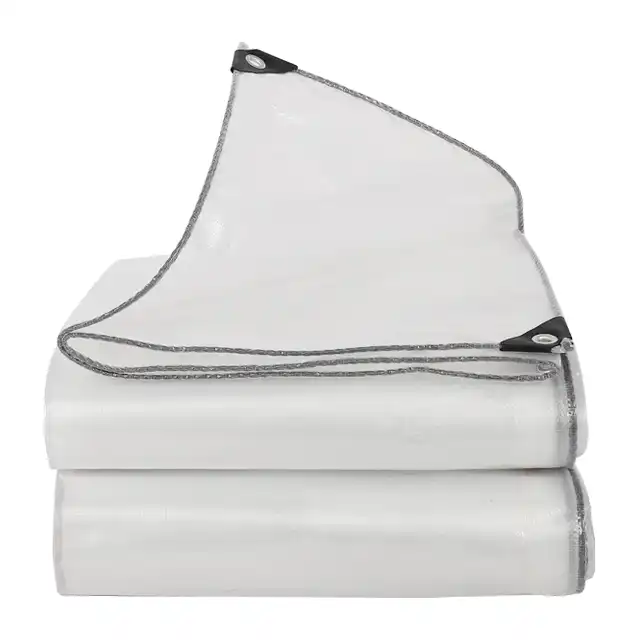How to Clean and Care for Your Camping Tarps?
Picture this: you've just returned from an incredible camping adventure, but your camping tarp is covered in mud, bird droppings, tree sap, and mysterious forest debris. A dirty, poorly maintained camping tarp not only looks unsightly but also loses its protective capabilities, develops mildew, and significantly shortens its lifespan. Proper cleaning and care for your camping tarp isn't just about aesthetics—it's about maximizing your investment and ensuring reliable protection on every outdoor adventure. This comprehensive guide will walk you through proven techniques to clean, maintain, and extend the life of your camping tarp, so you're always prepared for your next outdoor expedition.
Understanding Your Camping Tarp Material and Its Care Requirements

Before diving into cleaning procedures, understanding what your camping tarp is made from is absolutely critical to proper camping tarp care. Different materials require distinct approaches, and using the wrong cleaning method can permanently damage your tarp's waterproof coating or structural integrity. Most camping tarps today are manufactured from polyethylene (PE), which consists of high-density, tightly woven polyethylene fibers laminated on both sides to create exceptional waterproof protection. These PE tarpaulins feature materials like HDPE woven fabric combined with LDPE coating, creating a durable barrier against the elements. Quality camping tarps incorporate UV treatment ranging from one to seven percent to provide extra protection against harmful sun rays and prevent premature fading. The weight of camping tarps typically ranges from 65gsm to 280gsm, with middle-duty options falling between 100gsm and 180gsm, offering an excellent balance between durability and portability for camping applications. Understanding these material specifications helps you select appropriate cleaning solutions that won't compromise the tarp's engineered properties, including its waterproof lamination, UV-resistant coating, and tear-resistant construction.
-
Identifying Common Camping Tarp Construction Features
Modern camping tarps come with specific construction features designed to enhance durability and functionality in outdoor environments. Professional-grade camping tarps feature mesh counts ranging from 10x10 to 14x14, which refers to the weave density of the fabric, directly impacting strength and tear resistance. The thickness typically measures between 7 to 12 mil, providing substantial protection without excessive weight. High-quality camping tarps incorporate reinforced grommets at regular intervals, usually with rust-resistant metal rings that allow secure tie-down points for various camping configurations. The edges are often heat-sealed rather than sewn, creating stronger, more waterproof seams that resist tearing under tension. Many camping tarps also include rope-reinforced hems that add structural integrity along the perimeter, preventing edge tearing which is one of the most common failure points. When performing camping tarp care, special attention should be paid to these reinforced areas, as accumulated dirt and debris around grommets and seams can accelerate deterioration. Understanding these construction elements helps you implement targeted cleaning strategies that address vulnerable areas while preserving the tarp's engineered durability features.
Essential Pre-Cleaning Steps for Your Camping Tarp
The preparation phase is often overlooked but represents a critical component of effective camping tarp care. Before introducing any water or cleaning solutions, you must properly prepare your camping tarp to ensure thorough cleaning and prevent damage. Begin by selecting an appropriate cleaning location—an open, flat surface such as a driveway, patio, or large lawn area works best. The space should provide adequate drainage to prevent standing water and chemical runoff from affecting surrounding vegetation. Unfold your camping tarp completely, taking care to spread it smoothly across the surface without any wrinkles or folds that could trap dirt during cleaning. Once laid flat, conduct a thorough visual inspection of the entire tarp surface, checking for tears, punctures, weakened areas, or damaged grommets that may require repair before or after cleaning. Pay particular attention to high-stress areas like corners and grommet locations where damage commonly occurs. Next, remove loose debris by vigorously shaking the camping tarp or using a soft-bristled broom to sweep away pine needles, leaves, dirt clumps, dried mud, and other forest remnants. This preliminary debris removal prevents spreading dirt during the wet cleaning process and reduces the amount of scrubbing required.
-
Creating the Right Cleaning Solution for Camping Tarps
Selecting and preparing the appropriate cleaning solution is fundamental to successful camping tarp care without causing material degradation. For polyethylene camping tarps, a mild soap solution provides optimal cleaning power without compromising the waterproof coating or UV protection. Fill a large bucket with cold or lukewarm water—never use hot water, as elevated temperatures can cause polyethylene materials to shrink, warp, or lose their waterproof lamination. Add a small amount of mild dish soap or environmentally friendly biodegradable detergent, mixing thoroughly until the solution develops a gentle, soapy consistency. The ideal ratio is approximately one tablespoon of soap per gallon of water, though you can adjust based on how soiled your camping tarp has become. For camping tarps with moderate dirt accumulation, this mild solution is perfectly adequate. However, for heavily soiled camping tarps with stubborn stains like tree sap, grease, or organic matter, you may need to apply the solution more liberally and allow it to penetrate for 10 to 20 minutes before scrubbing. This soaking period helps break down layered dirt and loosens stubborn contaminants. Avoid using harsh chemicals, bleach, ammonia-based cleaners, or abrasive detergents, as these can deteriorate the polyethylene fabric, strip protective coatings, and reduce your camping tarp's lifespan. Remember that camping tarps made with UV protection and waterproof treatments require gentle cleaning agents that preserve these specialized coatings.
Proper Cleaning Techniques for Camping Tarps
With your camping tarp prepared and cleaning solution ready, it's time to implement proper cleaning techniques that remove dirt effectively while preserving material integrity. Begin by applying your mild soap solution liberally across the entire tarp surface using a garden hose with a spray nozzle or by pouring the solution directly from your bucket. Work systematically across the camping tarp in sections, ensuring complete coverage. Once the surface is thoroughly wetted with cleaning solution, use a soft-bristled brush or non-abrasive sponge to gently scrub the tarp, working in circular motions to lift embedded dirt without damaging the fabric weave. Focus particular attention on visibly soiled areas, corners, and sections around grommets where dirt tends to accumulate. For camping tarps with stubborn stains, apply additional cleaning solution directly to the problem area and allow it to sit for several minutes before scrubbing. The key to effective camping tarp care during the scrubbing phase is using moderate pressure—aggressive scrubbing can damage the polyethylene weave and compromise waterproof coatings. For particularly large camping tarps, consider enlisting help to manage the material effectively, as trying to clean an unwieldy tarp alone often results in incomplete cleaning or accidental damage.
-
Addressing Specific Stains on Camping Tarps
Different types of stains require specialized approaches within your overall camping tarp care routine. Tree sap, one of the most common and frustrating camping tarp contaminants, demands particular attention. To remove sap, first allow it to harden completely, then gently scrape off excess sap using a plastic putty knife or credit card, being careful not to gouge the tarp material. Apply a small amount of rubbing alcohol or a specialized sap remover to the affected area, let it sit briefly, then wipe clean with a soft cloth. For grease or oil stains, a degreasing dish soap works effectively—apply it directly to the stain, work it in gently with a soft brush, and rinse thoroughly. Mildew and mold stains, which develop when camping tarps are stored damp, require a different approach. Mix a solution of one part white vinegar to four parts water, or use a commercial mildew remover safe for polyethylene materials. Apply the solution to affected areas, let it sit for several minutes, then scrub gently with a soft brush before rinsing completely. Bird droppings should be allowed to dry completely before attempting removal, as wet droppings smear and penetrate deeper into the fabric. Once dry, scrape off the bulk with a plastic scraper, then clean the area with your standard soap solution. For camping tarps with UV treatment and waterproof coatings, always test any specialized cleaning solution on a small, inconspicuous area first to ensure it won't damage protective treatments.
-
Rinsing and Drying Your Camping Tarp Properly
Thorough rinsing represents a critical yet often rushed step in camping tarp care that directly impacts long-term material performance. After completing the scrubbing process, use a garden hose with good water pressure to rinse the camping tarp completely, ensuring all soap residue is removed from both sides of the material. Soap residue left on the tarp surface attracts dirt, creates sticky spots, and can degrade waterproof coatings over time. Start rinsing from one end and work systematically across the entire surface, paying special attention to seams, grommets, and reinforced areas where soap can accumulate. Flip the camping tarp over and repeat the rinsing process on the opposite side, as polyethylene tarps with laminated coatings have two distinct surfaces that both require thorough cleaning. For particularly large camping tarps or those with heavy soap application, multiple rinse cycles may be necessary. Once rinsing is complete, the drying phase begins—and this step is absolutely crucial for preventing mildew growth and material degradation. Never fold or store a damp camping tarp, as moisture trapped in folds creates an ideal environment for mold and mildew development. Instead, hang your camping tarp over a clothesline, fence, or sturdy rope stretched between two points, allowing air to circulate freely around both sides. If hanging isn't possible, lay the tarp flat on a clean surface in direct sunlight, which provides natural UV disinfection while accelerating drying. Ensure the camping tarp is completely dry to the touch on both sides before folding—this may take several hours to a full day depending on weather conditions, tarp thickness, and ambient humidity.
Storage Best Practices for Camping Tarps
Proper storage is an essential component of comprehensive camping tarp care that dramatically extends usable life between adventures. Once your camping tarp is completely dry and clean, the storage process begins with proper folding technique. Lay the tarp on a clean, flat surface and fold it neatly, creating uniform sections that prevent permanent creases or stress points. Many camping enthusiasts prefer the rolling method over folding, as rolling reduces crease formation and distributes stress more evenly across the material. If rolling your camping tarp, start from one end and roll tightly but not so tight that you create excessive compression stress on the polyethylene fibers. Before storing, conduct a final inspection for any damage that may have occurred during use or cleaning—small tears can be repaired with tarp repair tape or vinyl cement patches designed specifically for polyethylene materials. Select a storage location that is cool, dry, and protected from direct sunlight, as UV exposure during storage can degrade even UV-treated camping tarps over extended periods. Avoid storing camping tarps directly on concrete floors, as concrete can draw moisture and cause mildew development. Instead, place the folded or rolled tarp on a shelf, in a plastic storage bin with ventilation holes, or suspended in a tarp storage bag designed for outdoor gear. Keep your camping tarp away from sharp objects, chemicals, solvents, and petroleum products that could damage the polyethylene fabric or degrade waterproof coatings. For camping tarps used seasonally, consider inspecting them mid-storage period to verify they remain dry and undamaged.
-
Seasonal Camping Tarp Maintenance and Inspection
Implementing a regular maintenance schedule represents proactive camping tarp care that prevents small issues from becoming major problems. Spring and fall are ideal times for comprehensive camping tarp inspection and maintenance, particularly for tarps that see heavy seasonal use. Begin your seasonal maintenance by unfolding the camping tarp completely and conducting a systematic inspection of the entire surface, looking for signs of wear, UV degradation, weakened areas, or developing tears. Examine all grommets carefully, checking for rust, loosening, or pulling away from the fabric—damaged grommets should be replaced immediately using a grommet repair kit designed for the weight and thickness of your camping tarp. Inspect the reinforced edges and corners, as these high-stress areas often show wear before other sections. Check the waterproof coating by spraying a section with water and observing whether it beads properly or soaks into the fabric. If water absorption has increased, the waterproof coating may be degrading, and reapplication of a waterproofing treatment designed for polyethylene tarps may be necessary. For camping tarps with UV protection, look for signs of sun damage such as brittleness, color fading, or areas that feel thinner or weaker than surrounding material. Consider applying a UV protectant spray annually to camping tarps that receive significant sun exposure, as this supplemental protection extends the effective life of factory-applied UV treatments. Document any repairs made and track the overall condition of your camping tarp across seasons, as this information helps you anticipate when replacement may become necessary despite diligent care.
Advanced Camping Tarp Care and Repair Techniques
Beyond routine cleaning, comprehensive camping tarp care includes mastering repair techniques that restore damaged tarps to full functionality. Small tears and punctures are inevitable with regular camping use, but they don't necessarily mean your camping tarp has reached the end of its useful life. For minor tears less than two inches long, tarp repair tape provides a quick, effective solution. Clean and dry the damaged area thoroughly, cut a piece of repair tape that extends at least one inch beyond the tear on all sides, and apply it smoothly to prevent air bubbles that could compromise the seal. For best results, apply repair tape to both sides of the tear, creating a sandwich effect that distributes stress and prevents further tearing. Larger tears or punctures require more substantial repair using patch kits specifically designed for polyethylene camping tarps. These kits typically include adhesive patches or vinyl cement that bonds permanently to PE material. Cut the patch to size, ensuring it extends well beyond the damaged area, clean both surfaces with rubbing alcohol, apply the adhesive according to manufacturer instructions, and press firmly to create a secure bond. Allow the repair to cure for at least 24 hours before subjecting the camping tarp to any stress or tension. For camping tarps with damaged grommets, replacement is straightforward with the appropriate tools. Grommet kits include the replacement grommets, a hole punch or cutter, and a setting tool. Remove the damaged grommet, reinforce the area with repair tape if the fabric around the grommet hole has torn, punch a new hole if necessary, and install the replacement grommet following kit instructions.
-
Extending Camping Tarp Lifespan Through Proper Use
The most effective camping tarp care actually begins with proper use techniques that minimize damage during deployment. When setting up your camping tarp, avoid dragging it across rough surfaces, sharp rocks, or abrasive ground that can puncture or tear the material. Instead, carry the folded tarp to your setup location and unfold it carefully in place. Use adequate tie-down points and distribute tension evenly across all anchor points to prevent stress concentration that leads to grommet failure or fabric tearing. When securing your camping tarp, avoid over-tightening guy lines, as excessive tension can damage grommets, tear fabric at stress points, and stretch the material beyond its elastic limit. In windy conditions, ensure your camping tarp is properly secured with adequate anchor points to prevent excessive flapping, which creates repeated stress cycles that weaken fabric and accelerate wear. If wind conditions become severe, consider taking down your camping tarp temporarily rather than risk catastrophic damage. When breaking camp, take time to fold your camping tarp properly rather than stuffing it hastily into a bag, as careless packing can create permanent creases and compress the material unnecessarily. Remove all stakes, sticks, and debris before folding, as these items can puncture the tarp material during transport. During camping trips lasting multiple days, periodically inspect your camping tarp setup for developing issues such as pooling water, excessive sagging, or tension points that may indicate inadequate support or improperly positioned guy lines.
Choosing Quality Camping Tarps for Easier Maintenance
While proper camping tarp care is essential, starting with a high-quality camping tarp significantly reduces maintenance requirements and extends overall lifespan. Premium camping tarps manufactured from super strong, tightly woven polyethylene provide superior and long-lasting protection from the elements compared to lightweight, economy options. Quality construction features to look for include reinforced grommets with rust-resistant metal components, heat-sealed edges that create waterproof seams stronger than sewn alternatives, and rope-reinforced hems that prevent edge tearing. Professional-grade camping tarps incorporate high-strength yarn that provides extra UV protection against harmful sun rays and prevents premature fading, even with extended sun exposure. The waterproof capability is achieved through dual-surface lamination, where polyethylene fabric is laminated on both sides to create an impermeable barrier while maintaining flexibility in various temperatures. Look for camping tarps with arctic flexibility features, ensuring the material remains pliable rather than becoming brittle in cold weather conditions. Anti-freezing properties prevent ice damage during winter camping adventures. Quality camping tarps also offer tear-resistant construction that withstands accidental snags, punctures from falling branches, and general abrasion from camping activities. The availability of various weights, colors, and custom sizes allows you to select a camping tarp precisely matched to your specific camping needs, whether for lightweight backpacking or heavy-duty car camping applications. Camping tarps suitable for multiple applications such as ground covers, rain flies, sun shades, or picnic pads provide versatility that justifies investment in higher-quality materials.
-
Professional-Grade Camping Tarp Specifications
Understanding technical specifications helps you select camping tarps that balance durability with manageability while simplifying camping tarp care requirements. Professional manufacturers produce camping tarps with roll widths up to 5.1 meters, allowing creation of large tarps without central seams that represent potential failure points and leak sources. Sheet sizes are typically customizable upon request, accommodating specific camping shelter configurations. Weight options ranging from 100gsm to 180gsm for middle-duty camping tarps provide excellent balance between protective capability and packability for camping applications. Mesh counts from 10x10 to 14x14 indicate the weaving density, with higher counts generally providing greater strength and tear resistance, though at slightly increased weight. Thickness measurements between 7 to 12 mil indicate substantial material durability without excessive bulk. UV treatment percentages typically range from one to seven percent, with higher percentages providing enhanced protection for camping tarps frequently used in high-altitude or intense sunlight environments. Quality camping tarps feature 100 percent waterproof construction tested to ensure no moisture penetration under typical use conditions. Features like easy handling design, high durability construction, anti-corrosion properties, and shrink-proof materials all contribute to reduced maintenance requirements and extended service life. When evaluating camping tarp options, consider the specific environmental challenges you'll encounter—camping in high-UV environments requires tarps with enhanced UV treatment, while camping in wet climates demands superior waterproofing and mildew resistance.
Conclusion
Proper camping tarp care through regular cleaning, thorough drying, correct storage, and proactive maintenance dramatically extends your tarp's functional lifespan while ensuring reliable protection on every outdoor adventure. By implementing the techniques outlined in this guide and choosing quality camping tarps with professional-grade construction, you maximize your investment while minimizing maintenance time and replacement costs.
Cooperate with Linyi Shengde Plastic Co., Ltd.
When your camping adventures demand reliable, professional-grade protection, partner with Linyi Shengde Plastic Co., Ltd., the leading China camping tarp manufacturer established in 2003 with over 20 years of expertise. As a trusted China camping tarp factory and China camping tarp supplier, we produce high-quality camping tarps featuring tightly woven HDPE fabric with LDPE coating, delivering exceptional waterproof performance and UV protection. Our China camping tarp wholesale options include customizable weights, sizes, and colors to meet your specific requirements. With ISO 9001:2015 certification, partnerships with UNHCR, IOM, ICRC, and UNICEF, and exports to over 30 countries, we guarantee reliable quality, competitive camping tarp prices, and exceptional service. Browse our camping tarp for sale collection featuring high-quality camping tarps with tear-resistant construction and arctic flexibility. Contact us today at info@shengdetarp.com to discuss your camping tarp needs and receive a customized quote for premium camping tarps backed by decades of manufacturing excellence.
References
1. National Park Service. "Backcountry Camping Equipment Care and Maintenance." U.S. Department of the Interior.
2. Johnson, R. M., & Williams, T. E. "Polyethylene Tarpaulin Durability and Maintenance in Outdoor Applications." Journal of Outdoor Recreation Materials, Vol. 15, No. 3.
3. American Camping Association. "Guide to Camping Equipment Longevity Through Proper Care." Camping Standards and Safety Committee.
4. Thompson, K. L. "Waterproof Material Maintenance: Best Practices for Polyethylene Fabrics." International Journal of Textile Conservation, Vol. 28, No. 2.




